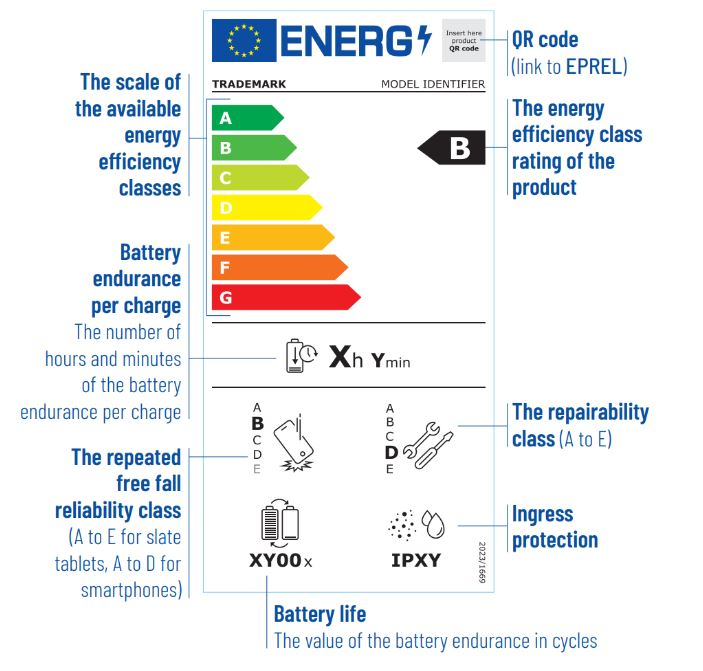Everything you need to know about the new EU Energy Label for smartphones and tablets

Energy label for smartphones and tablets mandatory since 2025
Since June 20, 2025, the energy label for smartphones and tablets has been mandatory within the European Union. These regulations require manufacturers, importers and sellers to provide clear information on energy consumption, battery life, repairability and durability. For companies operating in the European market, compliance is crucial. Instrux supports with advice, testing processes and full compliance guidance.
What does the energy label for smartphones and tablets mean?
The energy label shows consumers how energy-efficient and durable a device is. Information on the label includes battery life per charge, battery life, drop resistance, dust and water resistance (IP rating) and a repairability score. This data helps consumers make more sustainable choices and requires manufacturers to be more transparent.
What devices are covered by the regulations?
- Smartphones with a touchscreen from 4 to 7 inches
- Tablets without a physical keyboard from 7 to 17.4 inches
- Cordless phones
- Feature phones (basic functionality, no apps)
Exceptions apply to tablets with keyboards (such as Windows tablets), devices with flexible screens (rollables), secure communication devices and second-hand products – unless imported from outside the EU or substantially refurbished.
Obligations for web shops and dealers
For online sales, the energy label should be directly visible on the product page, near the price. This may be done via an energy arrow with a click-through to the full label and product data sheet. This display must comply with the requirements of Annex VIII of the European regulations.
What will change for manufacturers and importers?
Manufacturers and importers must register each product in the EPREL database before placing it on the market. They are also responsible for battery durability (at least 800 cycles while maintaining 80% capacity), provision of technical documentation and parts availability for seven years after the end of sales.
Why testing for the energy label is essential
Products must demonstrably meet technical standards and requirements. Independent laboratory testing is mandatory to substantiate this performance.
Important testing aspects include:
- Fall resistance (free fall reliability score A to E)
- Battery life per charge cycle
- Battery life (min. 800 charge-discharge cycles)
- Repairability Score
- Dust and water resistance (IP rating)
EPREL and the energy label: entering the market
EPREL (European Product Registry for Energy Labeling) is the central European database in which appliances must be registered before they can be sold. The data in EPREL must match the information on the energy label and in the technical documentation. Without correct registration, market access is prohibited.
How does Instrux help with your compliance?
Instrux supports companies in the complete process: from product analysis to testing, from documentation to EPREL registration. We advise on the correct testing methods, deliver compliant reports and ensure that your energy label is technically and legally correct. Moreover, we support you in setting up your webshop according to the legal requirements.
What you need to do now
Identify which of your products are covered by regulations. Have tests performed for battery, drop resistance and repairability. Register this data in EPREL and make sure your energy labels are displayed correctly – both physically and digitally. Instrux helps you step by step.
Conclusion
The energy label for smartphones and tablets is a powerful tool for sustainability as well as consumer education. But for companies it is above all a legal obligation. By acting now you can avoid delays, fines or exclusion from the market. Let Instrux – your partner in product compliance – guide you.
Want to know more or get started right away? Contact us at instrux.co.uk.
Frequently asked questions (FAQ)
1. Does the energy label also apply to refurbished appliances?
Only if they were imported from outside the EU or if they were completely reconditioned.
2. Do I need to modify my web shop?
Yes. The energy label and information sheet should be visible on the product page, near the price.
3. What is EPREL and why is it mandatory?
EPREL is the European product database, without registration you are not allowed to sell the product in the EU.
4. What tests are mandatory?
Drop tests, battery life tests, repairability and IP rating, among others, must be measured and documented.
5. Is the energy label mandatory for B2B sales?
Yes, the obligation applies to both B2C and B2B sales, as long as the product is offered on the EU market, regardless of the sales channel.
6. Can I use an energy arrow instead of the entire label?
Yes, an energy arrow may be used in online sales, provided it meets the requirements in Appendix VIII. The arrow must show the full label and information sheet at the first click or mouse-over.
7. How long must I keep parts available?
You are required to keep critical parts available to professional repairers for up to 7 years after the end of the product model’s sale.
8. What are the consequences of non-compliance?
Non-compliance can lead to warnings, fines, sales bans or recalls within the EU. Compliance up front is significantly cheaper than recovery after the fact.